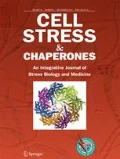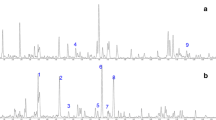Abstract
Berberine (BBR) is routinely prescribed in many Asian countries to treat diarrhea. Evidence from both animal and clinical investigations suggests that BBR exerts diverse pharmacological activities, including antidiabetic, antineoplastic, antihypertensive, and antiatherosclerotic effects. This study aimed to explore the cardioprotective mechanisms of BBR and to elucidate the modulations between autophagy and mitochondrial function during hypoxia/reoxygenation (H/R) in H9c2 cells. The degree of autophagic flux was assessed by pretreating H9c2 cells with BBR prior to H/R exposure and measuring the expression levels of Beclin-1 and green fluorescent protein (GFP)-labeled LC3B fusion proteins as well as the LC3II/LC3I ratio. The mitochondrial membrane potential (△Ψm) in H9c2 cells was evaluated by detecting rhodamine-123 fluorescence using flow cytometry. The results revealed that pretreatment with BBR upregulated autophagic flux and protected against the loss of the △Ψm in H9c2 cells subjected to H/R. We conclude that BBR attenuates mitochondrial dysfunction by inducing autophagic flux.







Similar content being viewed by others
Abbreviations
- ATP:
-
adenosine triphosphate
- AVs:
-
autophagic vacuoles
- GFP-LC3B:
-
green fluorescent protein-labeled LC3B
- H/R:
-
hypoxia/reoxygenation
- I/R:
-
ischemia/reperfusion
- LC3:
-
microtubule-associated protein 1 light chain 3
- TEM:
-
transmission electron microscopy
- △Ψm:
-
mitochondrial membrane potential
References
Angelos MG, Kutala VK, Torres CA, He G, Stoner JD, Mohammad M, Kuppusamy P (2006) Hypoxic reperfusion of the ischemic heart and oxygen radical generation. Am J Physiol Heart Circ Physiol 290:H341–H347. https://doi.org/10.1152/ajpheart.00223.2005
Choi AMK, Ryter SW, Levine B (2013) Autophagy in human health and disease. N Engl J Med 368:651–662. https://doi.org/10.1056/NEJMc1303158
Cohen I, Castedo M, Kroemer G (2002) Tantalizing Thanatos: unexpected links in death pathways. Trends Cell Biol 12:293–295. https://doi.org/10.1016/s0962-8924(02)02299-7
Cook SA, Sugden PH, Clerk A (1999) Regulation of bcl-2 family proteins during development and in response to oxidative stress in cardiac myocytes: association with changes in mitochondrial membrane potential. Circ Res 85:940–949. https://doi.org/10.1161/01.res.85.10.940
Dosenko VE, Nagibin VS, Tumanovska LV, Moibenko AA (2006) Protective effect of autophagy in anoxia-reoxygenation of isolated cardiomyocyte? Autophagy 2:305–306. https://doi.org/10.4161/auto.2946
Fan T, Huang Z, Chen L, Wang W, Zhang B, Xu Y, Pan S, Mao Z, Hu H, Geng Q (2016) Associations between autophagy, the ubiquitin-proteasome system and endoplasmic reticulum stress in hypoxia-deoxygenation or ischemia-reperfusion. Eur J Pharmacol 791:157–167. https://doi.org/10.1016/j.ejphar.2016.08.026
Fang XS, Zhang MH, Guo JY, Jin Z (2019) Effects of insulin-like growth factor-1 on endoplasmic reticulum stress and autophagy in rat gastric smooth muscle cells cultured at different glucose concentrations in vitro. Mol Cell Biochem 451:11–20. https://doi.org/10.1007/s11010-018-3388-7
Hou Q, Tang X, Liu H, Tang J, Yang Y, Jing X, Xiao Q, Wang W, Gou X, Wang Z (2011) Berberine induces cell death in human hepatoma cells in vitro by downregulating CD147. Cancer Sci 102:1287–1292. https://doi.org/10.1111/j.1349-7006.2011.01933.x
Hu J, Chai Y, Wang Y, Kheir MM, Li H, Yuan Z, Wan H, Xing D, Lei F, Du L (2012) PI3K p55γ promoter activity enhancement is involved in the anti-apoptotic effect of berberine against cerebral ischemia-reperfusion. Eur J Pharmacol 674:132–42.13. https://doi.org/10.1016/j.ejphar.2011.11.014
Huang Z, Han Z, Ye B, Dai Z, Shan P, Lu Z, Dai K, Wang C, Huang W (2015) Berberine alleviates cardiac ischemia/reperfusion injury by inhibiting excessive autophagy in cardiomyocytes. Eur J Pharmacol 762:1–10. https://doi.org/10.1016/j.ejphar.2015.05.028
Jia Z, Lin L, Huang S, Zhu Z, Huang W, Huang Z (2017) Inhibition of autophagy by berberine enhances the survival of H9C2 myocytes following hypoxia. Mol Med Rep 16:1677–1684. https://doi.org/10.3892/mmr.2017.6770
Kupatt C, Weber C, Wolf DA, Becker BF, Smith TW, Kelly RA (1997) Nitric oxide attenuates reoxygenation-induced ICAM-1 expression in coronary microvascular endothelium: role of NFkappaB. J Mol Cell Cardiol 29:2599–2609. https://doi.org/10.1006/jmcc.1997.0439
Li X, Wu DI, Shen J, Zhou M, Lu Y (2013) Rapamycin induces autophagy in the melanoma cell line M14 via regulation of the expression levels of Bcl-2 and Bax. Oncol Lett 5:167–172. https://doi.org/10.3892/ol.2012.986
Li C, Guan XM, Wang RY, Xie YS, Zhou H, Ni WJ, Tang LQ (2020) Berberine mitigates high glucose-induced podocyte apoptosis by modulating autophagy via the mTOR/P70S6K/4EBP1 pathway. Life Sci 243:117277. https://doi.org/10.1016/j.lfs.2020.117277
Liu JC, Chan P, Chen YJ, Tomlinson B, Hong SH, Cheng JT (1999) The antihypertensive effect of the berberine derivative 6-protoberberine in spontaneously hypertensive rats. Pharmacology 59:283–289. https://doi.org/10.1159/000028331
Liu D, Meng X, Wu D, Qiu Z, Luo H (2019) A natural isoquinoline alkaloid with antitumor activity: studies of the biological activities of berberine. Front Pharmacol 10:9. https://doi.org/10.3389/fphar.2019.00009
Masafumi KM, Ise H, Kolattukudy PE, Yamada M, Ikeda U (2008) MCP-1 induces cardioprotection against ischaemia/reperfusion injury: role of reactive oxygen species. Cardiovasc Res 78:554–562. https://doi.org/10.1093/cvr/cvn035
Meeran SM, Katiyar S, Katiyar SK (2008) Berberine-induced apoptosis in human prostate cancer cells is initiated by reactive oxygen species generation. Toxicol Appl Pharmacol 229:33–43. https://doi.org/10.1016/j.taap.2007.12.027
Ou F, Huang H, Zhang M, Chen M, Huang H, Huang F, Zhou S (2016) HMGB1 induces apoptosis and EMT in association with increased autophagy following H/R injury in cardiomyocytes. Int J Mol Med 37:679–689. https://doi.org/10.3892/ijmm.2016.2474
Przyklenk K, Dong Y, Undyala VV, Whittaker P (2012) Autophagy as a therapeutic target for ischaemia /reperfusion injury? Concepts, controversies, and challenges. Cardiovasc Res 94:197–205. https://doi.org/10.1093/cvr/cvr358
Ravaux J, Léger N, Hamel G, Shillito B (2019) Assessing a species thermal tolerance through a multiparameter approach: the case study of the deep-sea hydrothermal vent shrimp Rimicaris exoculata. Cell Stress Chaperones 24:647–659. https://doi.org/10.1007/s12192-019-01003-0
Romuk E, Jacheć W, Kozielska-Nowalany E, Birkner E, Zemła-Woszek A, Wojciechowska C (2019) Superoxide dismutase activity as a predictor of adverse outcomes in patients with nonischemic dilated cardiomyopathy. Cell Stress Chaperones 24:661–673. https://doi.org/10.1007/s12192-019-01011-0
Sadoshima J (2008) The role of autophagy during ischemia/reperfusion. Autophagy 4:402–403. https://doi.org/10.4161/auto.5924
Tan Y, Ou H, Xiao X, Zhong J, Dong M (2019) Irisin ameliorates septic cardiomyopathy via inhibiting DRP1-related mitochondrial fission and normalizing the JNK-LATS2 signaling pathway. Cell Stress Chaperones 24:595–608. https://doi.org/10.1007/s12192-019-00992-2
Thu VT, Kim HK, Long LT, Lee SR, Hanh TM, Ko TH, Heo HJ, Kim N, Kim SH, Ko KS, Rhee BD, Han J (2012) NecroX-5 prevents hypoxia/reoxygenation injury by inhibiting the mitochondrial calcium uniporter. Cardiovasc Res 94:342–350. https://doi.org/10.1093/cvr/cvs122
Wang Y, Huang Y, Lam KSL, Li Y, Wong WT, Ye H, Lau CW, Vanhoutte PM, Xu A (2009) Berberine prevents hyperglycemia-induced endothelial injury and enhances vasodilatation via adenosine monophosphate-activated protein kinase and endothelial nitric oxide synthase. Cardiovasc Res 82:484–492. https://doi.org/10.1093/cvr/cvp078
Wang N, Feng Y, Zhu M, Tsang CM, Man K, Tong Y, Tsao SW (2010) Berberine induces autophagic cell death and mitochondrial apoptosis in liver cancer cells: the cellular mechanism. J Cell Biochem 111:1426–1436. https://doi.org/10.1002/jcb.22869
Xu MG, Wang JM, Chen L, Wang Y, Yang Z, Tao J (2008) Berberine-induced mobilization of circulating endothelial progenitor cells improves human small artery elasticity. J Hum Hypertens 22:389–393. https://doi.org/10.1038/sj.jhh.1002311
Zhang W, Su X, Gao Y, Sun B, Yu Y, Wang X, Zhang F (2009) Berberine protects mesenchymal stem cells against hypoxia-induced apoptosis in vitro. Biol Pharm Bull 32:1335–1342. https://doi.org/10.1248/bpb.32.1335
Funding
This study was supported by the National Natural Science Foundation of China (project number: U1704167, to Dr. Cao), Henan Provincial Science and Technology Project (project numbers: 182102310525 (Dr. Cao), 172102310063 (Dr. Hao), and 202102310088 (Dr. Li)), Joint Construction Project of Henan Medical Science and Technology Tackling Plan (project number: 2018020475 (Dr. Zhu)), Henan Medical Science and Technology Tackling Plan Provincial-ministerial Coconstruction Project (project number: SB201902033 (Dr. Cao)), and Key scientific research projects of colleges and Universities of Henan Province (project number: 20A320086 (Dr. Li)).
Author information
Authors and Affiliations
Corresponding authors
Ethics declarations
All experiments were performed in accordance with the Animals (Scientific Procedures) Act 1986 and following approval from the Ethical Review Board.
Conflict of interest
The authors declare that they have no conflict of interest.
Additional information
Publisher’s note
Springer Nature remains neutral with regard to jurisdictional claims in published maps and institutional affiliations.
Rights and permissions
About this article
Cite this article
Zhu, N., Cao, X., Hao, P. et al. Berberine attenuates mitochondrial dysfunction by inducing autophagic flux in myocardial hypoxia/reoxygenation injury. Cell Stress and Chaperones 25, 417–426 (2020). https://doi.org/10.1007/s12192-020-01081-5
Received:
Revised:
Accepted:
Published:
Issue Date:
DOI: https://doi.org/10.1007/s12192-020-01081-5




